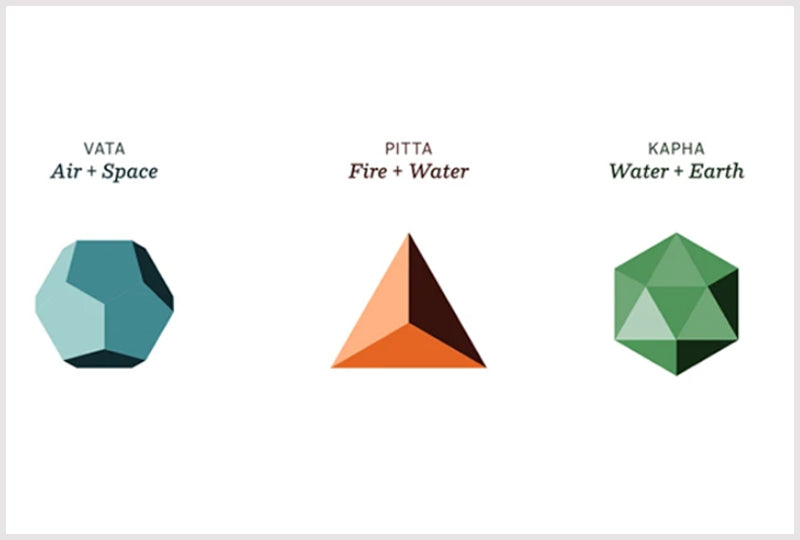
‘At the cellular level vata moves nutrients into and wastes out of cells, pitta digests nutrients to provide energy for cellular function, and kapha governs the cell's structure. In the digestive tract vata chews and swallows the food, pitta digests it. Vata assimilates nutrients and expels wastes, and kapha controls the secretions that lubricate and protect the digestive organs. In the mind, vata retrieves previous data from memory for comparison with new data. Pitta processes the new data and draws conclusions, which vata then stores as new memories. Kapha provides the stability needed for the mind to grasp a single thought at a time.’ - Courtesy : Prakriti, By Dr. Svoboda
1. Comparison based on Body Types
Low body weight, light bone structure, fast to act, forgetful, artistic, loves esoteric material, is shy and sensitive, enthusiastic. They are exceptionally changeable, and resist regularity in their lives because their active minds demand continual stimulation. When their energy is high they can be the life of the party, but burn out quickly.
Pitta Body Constitution:
Healthy body, well-developed muscles, well-functioning metabolism, an urge for physical activities, an interest in science and technical subjects, good speaking ability, aggressiveness, hostile tendency, impatient, tendency to baldness, good mental ability, excellent memory, loves intellectual activities.
Kapha Body Constitution:
Heavy body weight, solid body structure, strength, endurance, secure feeling, self-confident, not easily rattled, somewhat lethargic, patient, polite, generous, materialistic tendency, greedy, passive, tendency to sleep too much.
2. Emotions & Taste
Vs characteristically show fear or anxiety first, which is created by inherent Astringency. P types, full of heat of Pungency, ignite into anger first, whether they show it outwardly or merely burn with it internally. K people like to avoid confrontations because of their complacency of their innate Sweet. They have a strong disinterest in change , and their emotional sensitivity often shows when stressed by unpredictable situations.
3. Perception & Expression:
V people most often think predominantly in words. even, when they visualise ( thinking in images) or emote ( thinking in feelings) they usually use words to tie their thinking together.
P types are visually oriented and visualise almost everything they think about. P people use images to relate to words and emotions together.
Ks often think with their emotions and 'feel' the connection between words and forms. Emotions often influence K thinking as much as or more than their physical 'feel' for things.
4. Diseases that different body types are prone to:
Vata types are prone to rheumatism, nervous disorders,sciatica, insomnia, dry skin,constipation, receding gums,weak bones, infertility,impotence, colic, flatulence,stuttering, ringing in the ears,irregular menstruation with cramps, varicose veins, paralysis,blood clotting, anorexia, shivering fits, poor blood circulation.
Pitta types are prone to stress-related diseases; high blood pressure; coronary diseases;thrombosis; ulcers; cancer of the stomach, intestine, and skin;psoriasis; inflammation of the lymph system; infectious diseases;inflammation of the spleen;hepatitis, urinary tract infection;heartburn.
Kapha types are prone to nausea, colds, bronchitis, asthma, kidney stones, swollen lymphnodes, benign tumors, dropsy, goiter, lung and breast cancer, fungal infections, digestive system problems, and obesity.
Vayu (vata), pitta and kapha are, in brief, the three doshas of the body; each one is of three kinds- vriddhi (increase), kasha (decrease) and samba ( normal); both vriddhi (increase ) and ksaya( decrease) are three kinds; utkrsta (severe), madhya (moderate) and alpha (mild).
5. Chief areas of operation
Doshas are present predominantly in every cell of the body, but in some special places they are found abundantly. The organs of the trunk below the umbilicus are the chief sites of vata. Those between the umbilicus and the heart are the chief sites of pitta and those above the heart are the chief sites of kapha. Vata is the predominant dosha during old age, evening of the day, last part of the night and last stages of digestion of food; pitta is the predominant dosha during middle age, midday, midnight and middle stage of digestion of food; kapha is predominant during childhood, morning, early part of the night and at commencement of digestion of food.
6. Different body types have different digestive fire:
“Agni’ means the digestive fire.
Visamagni is unsteady or erratic digestive fire, which is changing from one day to another or from day to night; very unpredictable in accordance to qualities of vata types. Therefore, Vata types usually have an erratic digestion. They may feel hungry sometime, and other times they may not feel at all. They are prone to gas, flatulence and burping.
Tiksnagni is a high digestive fire, capable of digesting large quantities of food, very quickly and still desiring more , due to the nature and qualities of pitta. Therefore, Pitta types have a very good appetite, and can eat a huge amount of food at once. They are prone to acidity, or diarrhea and should avoid eating spicy food in excess.
Mandagni is low digestive fire, due to the nature and qualities of kapha. Therefore, Kapha types have poor and sluggish digestion, and can live without eating for long periods of time. It is important for them to include a little spice in their food to help rekindle their digestive fire and to stay alert through the day.
Samagni which is the digestive fire in normalcy is ideal for maintenance of health and helps in balancing the doshas.
7. Kostha (nature of the alimentary tract, bowel movements, nature of elimination of faeces) is also determined by the predominance of the doshas.
Predominance or increase of vata produces very hard faeces, with difficulty of elimination or even non-elimination. Predominance or increase of pitta causes watery or semi-solid faeces, moving out more than once or twice in a day. Predominance or increase of kapha causes soft, solid faeces moving out smoothly. When all the doshas are normal, then kostha will be madhya (moderate).
Some of our products that help in balancing the Vata dosha: Shubh Saanjh Chai, Prana Cookies, Ajwain Cookies, Cardamom Tea, Tummy love, Ortho heal capsule.
Some of our products that help in balancing the Pitta Dosha : Rose infusion, Mint infusion, Cardamom tea, Tejas Cookies, Livofly, Livofly SF, Desi Chai with Saunf, Fruit&Nut Cookies
Some of our products that help in balancing the Kapha Dosha : Ginger Tea, Suprabhat Chai, Masala Chai, Desi Masala Chai, Ojas Cookies, Diabe Choice cookies
Prakriti arising from the combination of all the three is the ideal vis-a-vis body constitution arising from the combination of any two predominant doshas.

Comments (0)
Back to News